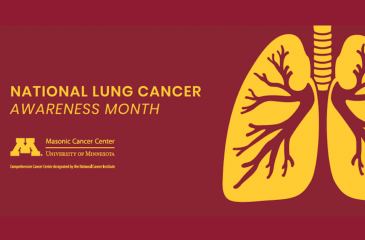Lung cancer awareness with the U of M: Smoking, radon, and cancer treatment and prevention
MINNEAPOLIS/ST. PAUL (11/11/2021) — Lung Cancer Awareness Month is recognized every year during the month of November. The Masonic Cancer Center and University of Minnesota, including the Medical School and the School of Public Health, have a number of renowned lung cancer researchers and doctors in our ranks, covering everything from lung cancer treatment, screening, and even prevention.
“Lung cancer is still the top cause of cancer-related deaths in the United States, in fact, lung cancer kills more people in the United States annually than breast, prostate, and colorectal cancers combined,” said Naomi Fujioka, MD, associate professor with the U of M Medical School’s Division of Hematology, Oncology, and Transplantation and a medical oncologist. “This is important to note because it's a disease that's stigmatized and research is underfunded despite the significant burden on Americans.”
The Centers for Disease Control and Prevention notes that, besides directly inhaling tobacco smoke, other risk factors include exposure to other people’s smoke (aka secondhand smoke), radon, air pollution, a family history of lung cancer, and asbestos. Approximately 10% to 20% of diagnosed lung cancer in the U.S. occur in people who never smoked or smoked fewer than 100 cigarettes in their lifetime.
Screening and treatment
There continue to be advancements in the treatment, screening, and prevention of lung cancer, with at least eight new targeted drugs for lung cancer approved in the last two years. These treatments are often more effective and better tolerated than older treatments like chemotherapy. Screening has led to decreased mortality from lung cancer. Improved treatments, particularly with immunotherapies and targeted therapies, have led to significantly improved survival rates.
“Lung cancer kills more women than breast cancer,” added Abbie Begnaud, MD, associate professor with the U of M Medical School’s Division of Pulmonary, Allergy, Critical Care, and Sleep Medicine. “But when detected early, through screening, for example, lung cancer cure rates are very high and much better than waiting for it to cause symptoms. Individuals over 50 who have smoked for many years should be screened. Lung cancer screening is covered by insurance, and we have a grant to cover uninsured persons.”
App to target commercial smoking
A study, led by Dana Carroll, PhD, assistant professor in the Division of Environmental Health Sciences, School of Public Health, will produce a culturally-tailored version of National Cancer Institute’s QuitGuide app with the potential to effectively combat commercial smoking among American Indian (AI) persons in the northern plains. The project is in collaboration with multiple community partners that include the American Indian Cancer Foundation, Native American Community Clinic, and Bad River Band of Lake Superior Chippewa.
“Commercial smoking and lung cancer among AI persons in the northern plains region of the U.S. are high, and while many AI persons want to quit smoking, lifetime quitting is lower in AI persons than persons of other race groups,” noted Dr. Carroll. “Low quitting among AI persons is likely attributed to a lack of access to or availability of smoking cessation treatment interventions that are tailored to the culture and unique needs of AI persons.”
Radon
In the state of Minnesota, the Black, AI, and Latino communities are disproportionately burdened with lung cancer. Behind cigarette smoking, radon is the second leading cause of lung cancer, with the average radon level in Minnesota being more than three times higher than the U.S. radon level. Radon exposure plus cigarette smoking can place Minnesotans at particularly high risk for lung cancer.
“Radon is a significant cancer concern in Minnesota. As part of the 10,000 Families Study we are beginning to collect household radon exposure among study participants,” said Heather Nelson, PhD, MPH, professor with the U of M School of Public Health (SPH) Division of Epidemiology and Community Health and a program co-leader with the Masonic Cancer Center. “Our goal is to gain a better understanding of who is exposed to high levels of radon and develop strategies to reduce exposure and prevent future cancers.The best way to reduce the risk of lung cancer from radon is to have your home tested for radon and follow up with mitigation if levels are high.”
-30-
About the Masonic Cancer Center, University of Minnesota
The Masonic Cancer Center, University of Minnesota, is the Twin Cities’ only Comprehensive Cancer Center, designated ‘Outstanding’ by the National Cancer Institute. As Minnesota’s Cancer Center, we have served the entire state for more than 25 years. Our researchers, educators, and care providers have worked to discover the causes, prevention, detection, and treatment of cancer and cancer-related diseases. Learn more at cancer.umn.edu.
About the University of Minnesota Medical School
The University of Minnesota Medical School is at the forefront of learning and discovery, transforming medical care and educating the next generation of physicians. Our graduates and faculty produce high-impact biomedical research and advance the practice of medicine. We acknowledge that the U of M Medical School, both the Twin Cities campus and Duluth campus, is located on traditional, ancestral and contemporary lands of the Dakota and the Ojibwe, and scores of other Indigenous people, and we affirm our commitment to tribal communities and their sovereignty as we seek to improve and strengthen our relations with tribal nations. For more information about the U of M Medical School, please visit med.umn.edu.
About the University of Minnesota School of Public Health
The University of Minnesota School of Public Health improves the health and wellbeing of populations and communities around the world by bringing innovative research, learning, and concrete actions to today’s biggest health challenges. We prepare some of the most influential leaders in the field, and partner with health departments, communities, and policymakers to advance health equity for all. Learn more at sph.umn.edu.
